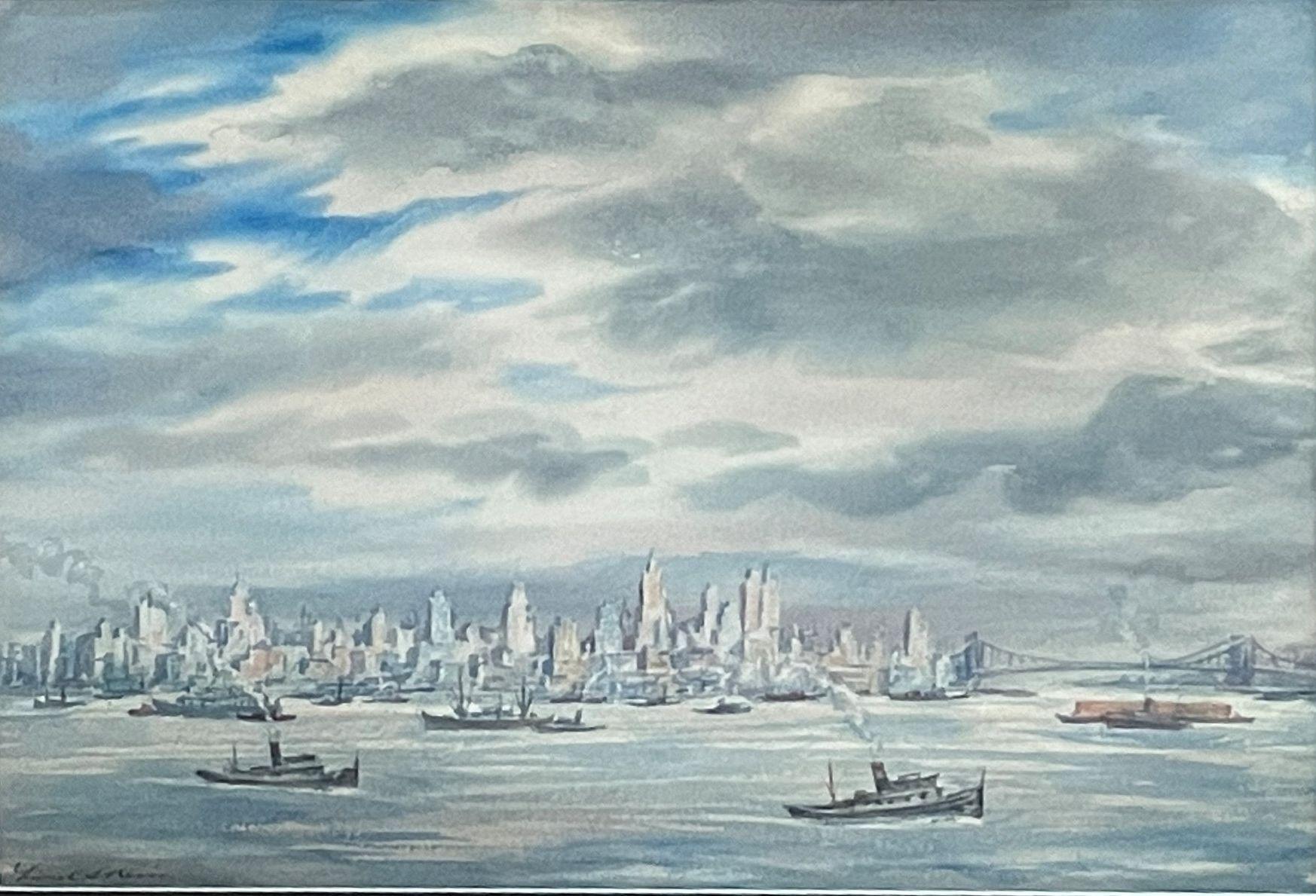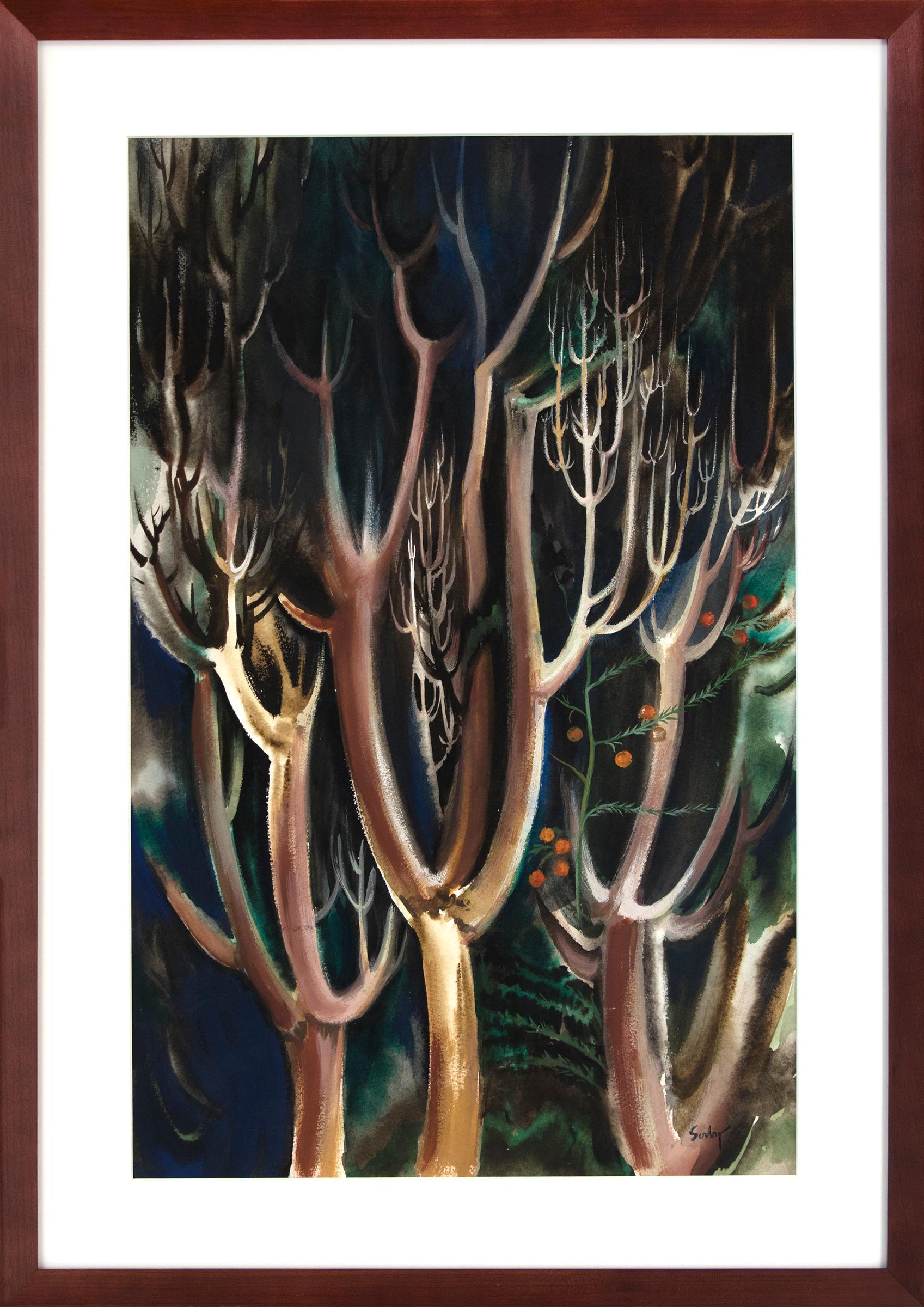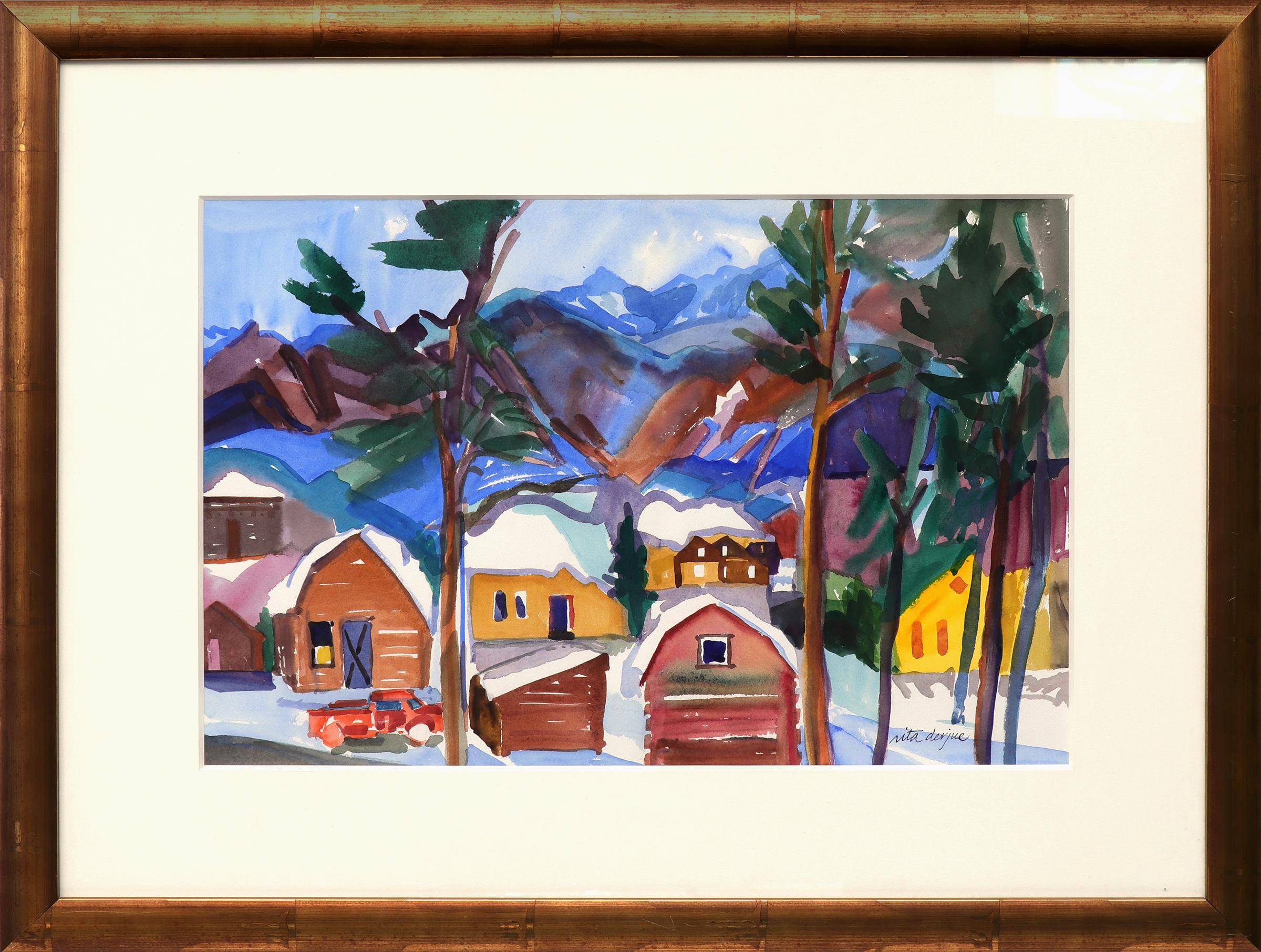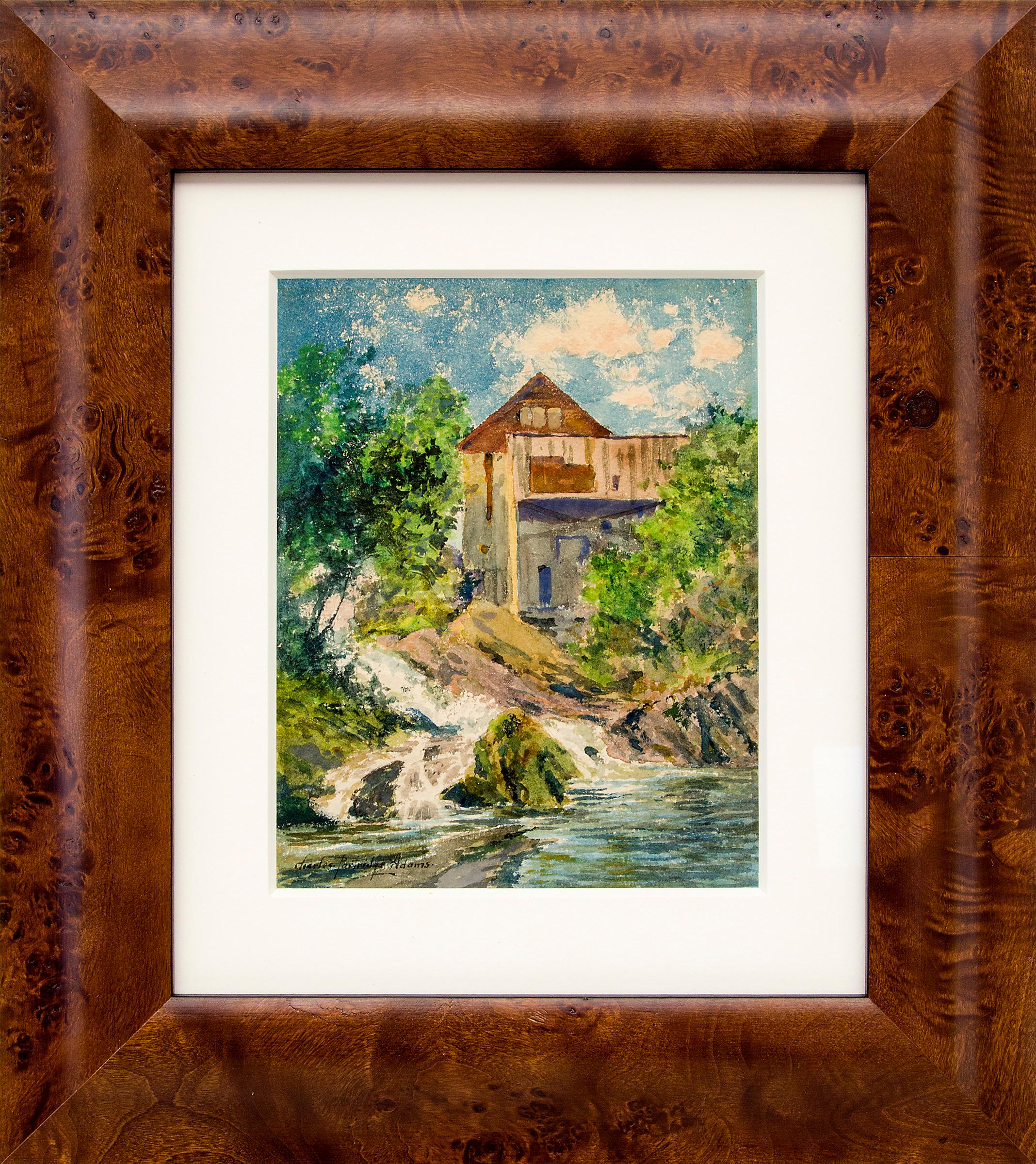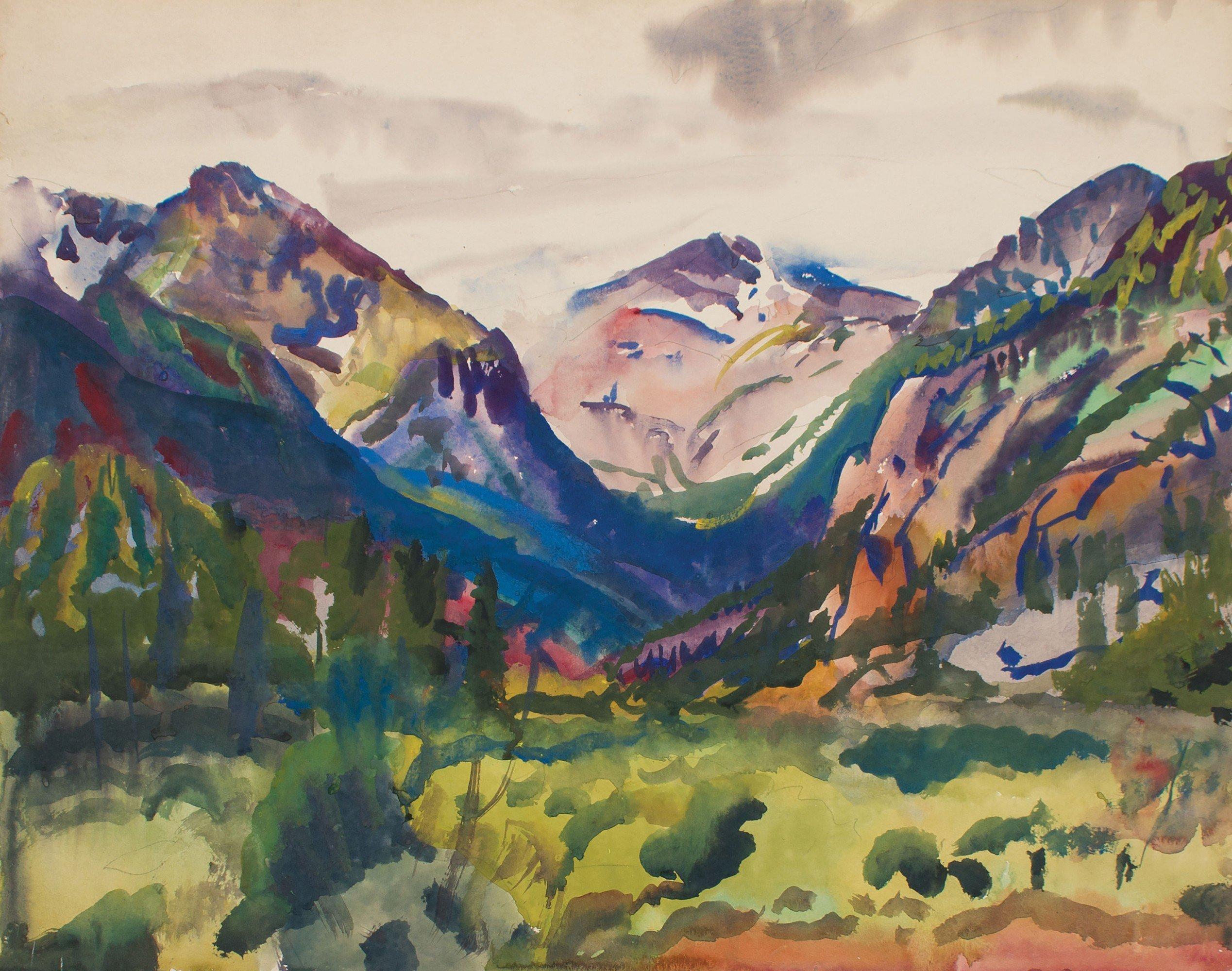Items Similar to "Sheepshead, Brooklyn, Long Island" Oscar Bluemner, Modernist Watercolor
Want more images or videos?
Request additional images or videos from the seller
1 of 9
Oscar Bluemner"Sheepshead, Brooklyn, Long Island" Oscar Bluemner, Modernist Watercolor1907
1907
About the Item
Oscar Bluemner
Sheepshead, Long Island, 1907
Signed with the artist's conjoined initials "OB" and dated "4-30 - 5 - 30" / "Aug 3, 07"
Watercolor on paper
6 x 10 inches
Provenance:
James Graham and Sons, New York
Sotheby's New York, American Paintings, Drawings and Sculpture, September 24, 2008, Lot 4
Private Collection, Scarsdale, New York
Exhibited:
New York, James Graham and Sons, America on Paper: Perspectives on People and Places by American Masters, 2000.
New York, James Graham and Sons, Modern Views: American Landscape Painting form 1918-1940, 2002.
New York, James Graham and Sons, Oscar Bluemner: Preparatory Drawings in Watercolor, Colored Pencil and Graphite, 2002.
The son and grandson of architects, Bluemner was born in Hanover, Germany, in 1867, and was encouraged to follow in his family's trade. He showed early promise as an artist as well, and his first one-man show of portraits was held at the Berlin Latin School in 1886. In 1892 he won a medal at the Royal Academy of Design in Berlin where he studied painting and architecture. Dissatisfied with the restrictive aesthetic policies of Emperor Wilhelm II's government, Bluemner left for America that same year.
Bluemner arrived in New York, then moved on to Chicago in 1893, hoping to gain architectural commissions at the World's Columbian Exposition. He designed prefabricated units for the Exposition and freelanced as a draftsman. He returned to New York in 1901, and the following year he won a commission for the Bronx Borough Courthouse that his partner finagled away using Bluemner's design. Although Bluemner sued and eventually won the lawsuit, the experience permanently turned him away from architecture. Between 1908 and 1910, Bluemner began painting in earnest, making sketching trips throughout New Jersey and Long Island. In 1910, the year he "kicked the building business over," he met Alfred Stieglitz, who sparked his interest in the artistic innovations of the European and American avant-garde. Bluemner painted his first oil in 1911.
In 1912 Bluemner sailed for Europe, where he had a one-man show of landscapes at the Gurlitt Galleries in Berlin. After Berlin, he traveled to Paris and Italy where he saw the work of Matisse, Cézanne, and the Futurists, and created thousands of sketches inspired by the museums he visited. Stopping over in England, Bluemner toured Roger Fry's Post-Impressionist exhibition at Grafton Galleries and became fully committed to the modernist ideology.
Upon his return to the United States, Bluemner contributed one landscape to the 1913 Armory Show and wrote an article defending modernism for Stieglitz's progressive publication Camera Work. The ongoing connection with Stieglitz had a significant impact on Bluemner's career—in 1915 Stieglitz gave him a solo exhibition at his gallery, 291. Bluemner's paintings of this period were tightly structured compositions in the Cubist manner blazing with Fauve-inspired reds, oranges, and contrasting hues. Bluemner exhibited in the 1916 Forum Exhibition and regularly at the Bourgeois Gallery (artist George Of introduced him to proprietor Stephan Bourgeois, who remained a lifelong friend). He also showed at the Montross Gallery, mainly exhibiting intensely colored oils synthesizing abstract and concrete form that were based on earlier sketches of New Jersey countryscapes and factories. Stieglitz continued to support him and gave him a solo show in 1928. The following year Bluemner had a one-man exhibition at the Whitney Studio Galleries.
Bluemner was fascinated with the formal, emotional, and spiritual qualities of strong color. He dubbed himself the "Vermillionaire" in reference to his reliance on bright red hues for his houses and barns. He explored his color theories in angular, brightly colored landscapes, abstracted from nature. As his career progressed, Bluemner found inspiration in classical music and Freudian concepts of the subconscious. His late compositions in oil or casein, on which he often bestowed titles alluding to music, became more abstract, displaying heightened emotional content, simplified masses, and pulsating color.
After his wife's death in 1926, Bluemner moved to South Braintree, Massachusetts, to live in virtual seclusion. He continued to paint and exhibit until he was involved in an auto accident and told he could never paint again. Bluemner died by his own hand on January 12, 1938.
Underappreciated and financially impoverished during his lifetime, Bluemner is today the object of renewed critical and public interest. In 2005-06, his career was the subject of a major retrospective, "Oscar Bluemner: A Passion for Color," organized by the Whitney Museum of American Art, New York. Bluemner is represented in private and public institutions, including the Metropolitan Museum of Art, New York; the Museum of Modern Art, New York; the Phillips Collection, and the Corcoran Gallery, both in Washington, D.C.; the Montclair Art Museum, New Jersey, and the Amon Carter Museum of Western Art, Texas.
- Creator:Oscar Bluemner (1867 - 1938, American)
- Creation Year:1907
- Dimensions:Height: 11 in (27.94 cm)Width: 15.5 in (39.37 cm)
- Medium:
- Movement & Style:
- Period:
- Condition:
- Gallery Location:New York, NY
- Reference Number:1stDibs: LU1841213139922
About the Seller
5.0
Platinum Seller
These expertly vetted sellers are 1stDibs' most experienced sellers and are rated highest by our customers.
Established in 2021
1stDibs seller since 2022
59 sales on 1stDibs
Typical response time: 1 hour
- ShippingRetrieving quote...Ships From: New York, NY
- Return PolicyA return for this item may be initiated within 3 days of delivery.
More From This SellerView All
- "New York City Skyline View from the East River, " Lionel Reiss, Jewish ArtistBy Lionel ReissLocated in New York, NYLionel S. Reiss (1894 - 1988) New York City Skyline View from the East River Watercolor on paper 13 x 19 inches Signed lower left In describing his own style, Lionel Reiss wrote, “By nature, inclination, and training, I have long since recognized the fact that...I belong to the category of those who can only gladly affirm the reality of the world I live in.” Reiss’s subject matter was wide-ranging, including gritty New York scenes, landscapes of bucolic Bucks County, Pennsylvania, and seascapes around Gloucester, Massachusetts. However, it was as a painter of Jewish life—both in Israel and in Europe before World War II—that Reiss excelled. I.B. Singer, the Nobel Prize winner for Literature, noted that Reiss was “essentially an artist of the nineteenth century, and because of this he had the power and the courage to tell visually the story of a people.” Although Reiss was born in Jaroslaw, Poland, his family immigrated to the United States in 1898 when he was four years old. Reiss's family settled on New York City’s Lower East Side and he lived in the city for most of his life. Reiss attended the Art Students League and then worked as a commercial artist for newspapers and publishers. As art director for Metro-Goldwyn-Mayer, he supposedly created the studio’s famous lion logo. After World War I, Reiss became fascinated with Jewish life in the ‘Old World.’ In 1921 he left his advertising work and spent the next ten years traveling in Europe, the Middle East, and North Africa. Like noted Jewish photographers Alter Kacyzne and Roman Vishniac, Reiss depicted Jewish life in Poland prior to World War II. He later wrote, “My trip encompassed three main objectives: to make ethnic studies of Jewish types wherever I traveled; to paint and draw Jewish life, as I saw it and felt it, in all aspects; and to round out my work in Israel.” In Europe, Reiss recorded quotidian scenes in a variety of media and different settings such as Paris, Amsterdam, the Venice ghetto, the Jewish cemetery in Prague, and an array of shops, synagogues, streets, and marketplaces in the Jewish quarters of Warsaw, Lodz, Krakow, Lublin, Vilna, Ternopil, and Kovno. He paid great attention to details of dress, hair, and facial features, and his work became noted for its descriptive quality. A selection of Reiss’s portraits appeared in 1938 in his book My Models Were Jews. In this book, published on the eve of the Holocaust, Reiss argued that there was “no such thing as a ‘Jewish race’.” Instead, he claimed that the Jewish people were a cultural group with a great deal of diversity within and between Jewish communities around the world. Franz Boas...Category
1940s American Modern Landscape Drawings and Watercolors
MaterialsPaper, Watercolor
- "Tokyo Diptych, " Yvonne Jacquette, Japanese Urban Cityscape Nocturnal AerialBy Yvonne JacquetteLocated in New York, NYYvonne Jacquette (American, b. 1935) Tokyo Diptych, 1985 Pastel on paper Overall 17 1/4 x 28 1/2 inches Signed lower center Provenance: Carey Ellis Company, Houston, Texas Brooke Alexander, New York Collection of an American Corporation Exhibited: New York, Brooke Alexander, Yvonne Jacquette: Tokyo Nightviews, April 5 - May 3, 1986, n.p., illustrated; this exhibition later traveled to Brunswick, Maine, Bowdoin College Museum of Art, Yvonne Jacquette: Tokyo Nightviews, June 27 - August 24, 1986. Yvonne Jacquette has a preference for high places, a circling plane, a penthouse window, an aerie from which to watch the world. Her work has often depicted the city and man-made landscape from the vantage of angels. It is a privileged perspective, long loved by photographers, who were perhaps the first to recognize the geometric grandeur of the city below. That grandeur structures Jacquette's images but is not its full content. Her work attempts to resolve the visual and emotional pardoxes of the modern metropolis. Only from the tower is there the possibility of order and context. And unlaced beauty. Jacquette first visited Japan in 1982. Nighttime Tokyo, its cars and crowds and canyons of loud Vegas neon, made a vivid and bewildering impression on her. The neon signs, pulsing, scaling the walls of high rises, fascinated the artist, "like Times Square spread over miles." Her fascination was equal parts marvel, confusion, and curiosity—the sparks of art. She returned to Tokyo in May of 1985, choosing hotel rooms with expansive vistas. From these views Jacquette excerpted images for a series of pastel night scenes. The basic forms and colors of each drawing were blocked in during night sessions by the window. She worked in the dark, selecting colors by flashlight. In daylight, she sharpened the geometry and corrected ambiguous passages. She refined the drawings further in the studio until the images read clearly. Photographic correctness was not important. The finished drawings are complete statements, not simply preparatory sketches for paintings. They have the authority of expert witness. In clear, discreet jots of pastel they record the performance of seeing, each touch of color attesting to a moment's close scrutiny. Yvonne Jacquette was born on December 15, 1934 in Pittsburgh, Pennsylvania and grew up in Stamford, Connecticut. She attended the Rhode Island School of Design, Providence from 1952 to 1955, when she moved to New York City. Her late husband was photographer Rudy Burckhardt, and the couple were part of a circle of artist friends that included Fairfield Porter, Alex Katz, Red Grooms, and Mimi Gross. She continues to live and work in New York City, as well as in Searsmont, Maine. A flight to San Diego in 1969 sparked Jacquette’s interest in aerial views, after which she began flying in commercial airliners to study cloud formations and weather patterns. She soon started sketching and painting the landscape as seen from above, beginning a process that has developed into a defining element of her art. Her first nocturnal painting...Category
1980s American Modern Landscape Drawings and Watercolors
MaterialsPaper, Pastel
- "New York City Harbor (Brooklyn Bridge), " Leon Dolice, East River, Mid-CenturyBy Leon DoliceLocated in New York, NYLeon Dolice (1892 - 1960) New York Harbor (Brooklyn Bridge), circa 1930-40 Pastel on paper 12 x 19 inches Signed lower right Provenance: Spanierman Gallery, New York The romantic b...Category
1930s American Modern Landscape Drawings and Watercolors
MaterialsPaper, Pastel
- "New York City Harbor" Leon Dolice, Downtown Skyline, East and Hudson RiverBy Leon DoliceLocated in New York, NYLeon Dolice (1892 - 1960) New York Harbor Skyline at Twilight (Searching), circa 1930-40 Pastel on paper 12 x 19 inches Signed lower left Provenance: Spanierman Gallery, New York T...Category
1930s American Modern Landscape Drawings and Watercolors
MaterialsPaper, Pastel
- "Hydrangeas, " Walter Inglis Anderson, Mississippi Southern Illustrator, FlowersLocated in New York, NYWalter Anderson ( American, 1903 - 1965) Hydrangeas, circa 1950 Mixed media on paper 11 x 8 1/2 inches Provenance: Luise Ross Gallery, New York Private Collection, New Jersey Acquired from the estate of the above, 2021 Walter Anderson firmly believed that quality art was an important part of life and should be made available to everyone. As he said, "There should be simple, good decorations, to be sold at prices to rival the five-and-ten." Noticing that only poor quality art was available in stores and little was available for children, he resolved to make art which could be reproduced easily and sell inexpensively — linoleum block prints. This technique enabled him to provide affordable, quality art. The technique of linoleum block printing is a simple concept; however, it requires much skill and talent to actually produce memorable art. Anderson purchased surplus "battleship linoleum," thicker than ordinary linoleum with a burlap backing for better support, to create his blocks. During the mid-1940s, he created almost 300 linocuts working in the attic of the sea-side plantation house, Oldfields, his wife's family home in Gautier. Masses of linoleum chips accumulated at the foot of the attic stairs as he often worked night and day. He began with sketching out a design directly on the linoleum. Once he had carved the image into the surface, he used the back of faded, surplus stock wallpaper that a friend sent him, laying long strips on top of the inked linoleum. A roller made of sewer pipe filled with sand served as his press. When the print was completed, he often colored it by hand with bold strokes and vivid colors. The prints were sold at Shearwater Pottery, the family business, for a mere dollar a foot. But "what about a well-designed fairy tale for a child's room?" he asked himself. Since there was a lack of affordable art for children, much of his work with linoleum blocks focused on subjects for children. He depicted fables and fairy tales ranging from Arabian Nights, to Germany and the Grimm Brothers' Rapunzel, to the French story of The White Cat, to the Greek tales such as Europa and the Bull, and to tales from China, India, and other cultures. Anderson also created "mini" books featuring the alphabet and Robinson Cat. The blocks are not only alive with the story being depicted, but they are also filled with designs taken from Best-Maugard's Method for Creative Design. Swirls, half-circles and zig-zag lines fill every available space on the linoleum block making them come alive and capture their audience. But fairy tales, children's verses and the "mini" books, consisting of about 90 blocks, were not the sole subject of Anderson's linoleum block prints. In total, he created approximately 300 linoleum blocks with subjects ranging from coastal flora and fauna, coastal animals, and sports and other coastal activities. Anderson even created linoleum blocks to be used to print tablecloths and clothing, some worn by his own children. Color and subjects of the linoleum block prints were not the only things that got them noticed. In 1945 when Anderson was creating these prints, the standard size of linoleum block prints was only 12 by 18 inches. These small dimensions were due to the common size of the paper available and the restrictions made by national competitions. Since Anderson used wallpaper...Category
Mid-20th Century American Modern Landscape Paintings
MaterialsPaper, Crayon
- "Tugboat at Dock, " Reginald Marsh, Modern WPA Industrial ShipBy Reginald MarshLocated in New York, NYReginald Marsh Tugboat at Dock, circa 1937 Signed lower right Watercolor and pencil on paper 13 3/4 x 20 inches Housed in a Lowy frame. Provenance: Sotheby'...Category
1930s Modern Landscape Paintings
MaterialsPaper, Watercolor, Pencil
You May Also Like
- Modernist Trees, 1940s Framed Modernist Landscape Watercolor Painting, Red GreenBy Richard SorbyLocated in Denver, COModernist painting of trees, interior forest scene by Colorado artist, Richard Sorby (1911-2001). Painted in dark colors of green, blue and black with brown, orange and white. Water...Category
1940s American Modern Landscape Drawings and Watercolors
MaterialsWatercolor, Archival Paper
- Colorado Mountain Winter Landscape Watercolor Painting, Blue, Orange, PurpleLocated in Denver, COColorado mountain landscape watercolor painting signed by artist Rita Derjue (1934-2020) depicts Cabins in the Snow in bright tones of blue, yellow, green and red/brown. Signed by the artist in the lower right corner. Presented in a custom frame with archival materials, outer dimensions measure 24 ⅛ x 31 ½ x 1 ¼ inches. Image sight size is 14 ½ x 21 ½ inches. About the Artist: Born Rhode Island, 1934 Artist, educator, mentor and community activist, Derjue is the daughter of European parents whose family members had previous connections with New York and New England. Her drawing talent as a youngster in Rhode Island caught the attention of family friend Johann Groen, a Dutch-born painter and photographer, who encouraged her to spend time touring and studying in Europe to further her art education. In 1956 she earned her Bachelor of Fine Arts degree at the Rhode Island School of Design that emphasized the fundamentals of drawing and design. Her most memorable teacher was Richard Hamilton, whose work was influenced by German Expressionist Max Beckmann and the jazz greats. Her studies from nature and Cubist compositions done at that time reflect her interest in early twentieth-century European modernist painting. She had the opportunity to experience it firsthand during a year of post-graduate work at the renowned Akademie den Bildenden Kunste in Munich, Germany, in 1956-57. She studied with Ernest Geitlinger (1895-1972) whom the Nazi government classified as a “degenerate” artist in the 1930s, preventing him from exhibiting in Germany. After World War II he was one of the co-founders of the Munich artists’ association, Neue Gruppe, in 1946 and played an important role in abstract painting. While studying with him in Munich she produced a number of canvases in a referential abstract style. She also became acquainted with the Blaue Reiter group that flourished in the early twentieth century and whose expressionism strongly influenced her color palette and painting style. She particularly admired the work of Blaue Reiter co-founder and Wassily Kandinsky’s long-time partner, Gabriele Münter, whose work she studied at the Lenbachhaus in Munich and at the Gabriele Münter Haus and the Schlossmuseum in Murnau south of Munich. Derjue’s immersion in German Expressionism imparted a bold, simplified style to her work. In 1958 with a friend from Munich she went to Mexico for a year, studying with artist Frank Gonzalez in his studio in San Angel, Mexico City, and with Canadian artist, Toni Onley, in San Miguel de Allende. Onley had recently won a scholarship to the Instituto Allende to study mural and fresco painting with David Siqueiros, one of the three greats of Mexican muralism. At the Instituto Onley began painting large black-and-white canvases in an abstract impressionistic style which he imparted to Derjue, who thereafter began exploring color and space in the dimensions of her own large compositions. With writer Gregory Strong, he subsequently published Onley’s Arctic and his autobiography, The Tony Onley Story. After returning to the United States, she worked as a graphic designer for Little, Brown and Company, publishers in Boston. She began dating her future husband, Carle Zimmerman, whom she met earlier in Europe and whom she married in 1960. Joining him at Cornell University where he was completing his Ph.D degree, she earned her Master of Arts degree at the same institution and participated in group shows at the Herbert F. Johnson Museum and the Munson-Williams-Proctor Arts Institute in upstate New York. In 1963 Derjue and her husband relocated to Littleton, Colorado, where he spent his entire career, first as a research engineer and later as a departmental manager for the Marathon Oil...Category
20th Century American Modern Landscape Paintings
MaterialsWatercolor, Archival Paper
- Mill Near Plainfield, New Hampshire, Landscape Painting, Charles Partridge AdamsBy Charles Partridge AdamsLocated in Denver, CO"Mill Near Plainfield, New Hampshire" is an original, signed watercolor painting by artist Charles Partridge Adams (1858-1942), circa 1900. Singed by the artist in the lower left corner. Portrays a mill along a river with trees and clouds, painted in shades of brown, green, gray, and blue. Presented in a custom frame, outer dimensions measure 13 ¾ x 12 ¼ x 1 ¼ inches. Image size is 7 x 5 inches. Expedited and international shipping is available - please contact us for a quote. About the Artist: Born Massachusetts, 1858 Died 1942 Born in Franklin, Massachusetts, Charles Partridge Adams moved with his mother and two sisters to Denver, Colorado, in 1876 in an effort to cure the two girls who suffered from tuberculosis. In Denver, Adams found work at the Chain and Hardy Bookstore. He received his first, and only, art training from the owner's wife, Helen Chain. Mrs. Chain, a former pupil of George Inness, provided instruction and encouragement to the young artist and introduced him to other artists in the area including Alexander Phimister Proctor...Category
20th Century American Modern Landscape Drawings and Watercolors
MaterialsWatercolor, Archival Paper
- 1930s Colorado Modernist Landscape Painting of Trees, Mountains & HousesLocated in Denver, COColorado Modernist landscape, watercolor on paper by Turner B. Messick (1878-1952) from 1938. Tree with houses and mountains in the background, pain...Category
1930s American Modern Landscape Paintings
MaterialsArchival Paper, Watercolor
- Shower at Head of ValleyBy Frank WilcoxLocated in Beachwood, OHShower at Head of Valley, c. 1950 Watercolor on paper Frank Nelson Wilcox (October 3, 1887 – April 17, 1964) was a modernist American artist and a master of watercolor. Wilcox is described as the "Dean of Cleveland School painters". In 1906 Wilcox enrolled from the Cleveland School of Art...Category
1950s American Modern Landscape Drawings and Watercolors
MaterialsWatercolor
- Cliffs at Paramé, France, 20th century seascape & landscape watercolorBy Frank WilcoxLocated in Beachwood, OHFrank Nelson Wilcox (American, 1887-1964) Cliffs at Paramé, France, c. 1926 Watercolor on paper Signed lower right 14 x 17.5 inches Frank Nelson Wilcox (October 3, 1887 – April 17...Category
1920s American Modern Landscape Drawings and Watercolors
MaterialsWatercolor
